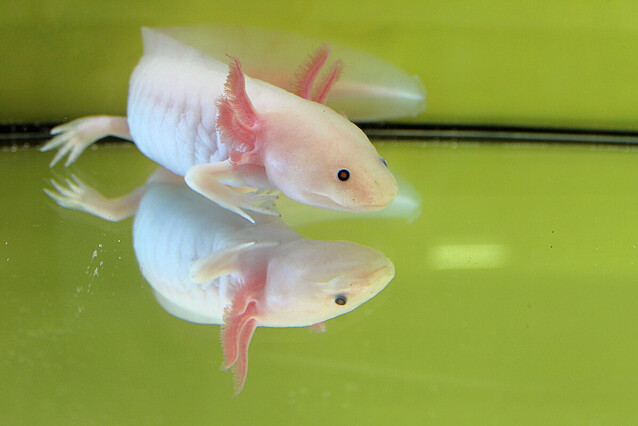A refined axolotl genome assembly sheds light on basic cellular processes
After the first assembly of an axolotl genome was published in 2018, the lab of Elly Tanaka teamed up with scientists at the University of Kentucky to take the next step and assembled the genome at the chromosome scale. In a study now published in the journal PNAS, the scientists show that gene regulation in axolotls occurs over very large genomic distances, and that chromosomes are packaged efficiently during mitotic cell divisions.
The Mexican axolotl Ambystoma mexicanum, a peculiar salamander with a debonair “Mona Lisa smile”, has an astonishing ability to regenerate damaged or lost body parts. This phenomenon has received a lot of attention – the lab of Elly Tanaka has been studying it at the molecular level for years. These investigations have led to the discovery of the axolotl’s other remarkable feature: its exceptionally large and repetitive genome.
In 2018, the Tanaka Lab together with colleagues in Germany were the first to sequence, assemble, annotate, and analyse the axolotl genome. The sequencing efforts yielded long reads able to span extensive, repetitive regions of the genome, but the scientists could not reach a greater level of detail in their reconstruction. This year, the Tanaka Lab and collaborators at the University of Kentucky took another approach: they used Hi-C, a method that quantifies the short and long-distance interactions between different parts of the genome. Once they identified the genome fragments that engage in short-distance contacts, the scientists could deduce the original order of genomic sequences at the chromosome scale. The final assembly and analysis were just published in the journal PNAS.

“Technology has moved forward and allowed us to achieve a chromosome-scale assembly of the axolotl’s genome, shedding light on its chromatin structure and the organisation of large-scale structural and functional units,” says Siegfried Schloissnig, co-first author, Computer Scientist and Biologist at the IMP.
The scientists’ study reveals that gene regulation in the axolotl genome can occur over very large genomic distances. Furthermore, it shows that the axolotl’s chromosomes are packed very efficiently during mitotic cell divisions.
“We’ve built upon our previous work to refine the axolotl genome sequence and map it more precisely,” explains Akane Kawaguchi, co-first author of the study and a postdoctoral fellow in the Tanaka Lab. “We finally have a full picture of the axolotl genome – it will certainly allow other researchers to further their understanding of the evolution of large genomes, gene regulation, and complex gene loci.”
Original publication
Schloissnig, S.*, Kawaguchi, A.*, Nowoshilow, S.*, Falcon, F.*, Otsuki, L., Tardivo, P., Timoshevskaya, N., Keinath, M. C., Smith, J. J., Voss, S. R., Tanaka, E. M.: “The giant axolotl genome uncovers the evolution, scaling and transcriptional control of complex gene loci”. PNAS, 13 April 2021, DOI: 10.1073/pnas.2017176118
*co-first authors
Read more
